Just looking for our Best Industrial Electrician Website examples list?
When designing a website for your electrical business, it’s important to focus on strategies that enhance the user experience and drive business results. Here are the key takeaways for building a high-performance electrician website:
- User-Focused Design is Crucial for Engagement
A well-organized and visually appealing website is essential for keeping potential clients engaged. Prioritize clear navigation, responsive design, and an intuitive layout to ensure visitors can easily find the information they need about your electrical services. - Local SEO is Vital for Visibility
For professional contractors, ranking in local search results is essential. Incorporate location-specific keywords and optimize your Google My Business listing to improve visibility in search engines and attract nearby clients searching for electrical contractors. - Effective Call-to-Action (CTA) Drives Conversions
Your website should have clear, compelling CTAs that guide visitors toward taking the next step—whether it’s requesting a quote, scheduling a service, or contacting you directly. Position CTAs prominently to maximize lead generation. - Service Pages Should Be Detailed and Informative
Each service you offer should have its own dedicated page with detailed descriptions. This helps potential clients understand what you offer and aids in optimization by targeting specific search queries related to your services. - Build Trust with Testimonials and Credentials
Featuring customer reviews, certifications, and industry affiliations on your site helps establish credibility and trust with prospective clients. This is especially important for businesses where safety and reliability are top concerns. - Optimize for Speed and Mobile Performance
Today, a slow-loading website or one that isn’t mobile-friendly can drive potential clients away. Optimize your website’s speed and ensure it’s responsive on all devices to enhance the user experience and improve overall rankings.
By focusing on these key elements, your website can become a powerful tool to attract local clients, cement trust, and ultimately grow your business.
Why Great Electrician Website Design is Key to Business Success
Now more than ever, a website is the cornerstone of your online presence. Whether you’re an electrical contractor, a small electrical business, or an industry leader, your website design can directly impact your ability to attract and convert potential clients. A great website cements trust and helps you stand out in a highly competitive market. Studies show that over 75% of potential customers judge a business’s credibility based on its website’s design.
When it comes to an electrician’s website design, the details matter. A visually appealing, well-structured site that is easy to navigate can leave a lasting first impression on website visitors. But it’s not just about aesthetics; it’s also about functionality and ensuring that your site is optimized for search engines. Great design is essential for SEO, ensuring your electrical services are easily found in search results, especially when potential clients are looking for the best option near them.
In this comprehensive guide, we’ll explore how a high-performing website can elevate your business results. We’ll dive into key design principles that attract visitors and turn them into leads. We’ll show you why investing in a professional website—whether through a custom-built site or a carefully chosen website builder—can pay off in the long run.
Website Planning & Purpose: The Foundation of Effective Web Design
The planning phase of an electrician’s website design is crucial, as it sets the foundation for everything that follows. It is during this phase that the purpose of the website is defined, and a clear strategy is established. This planning phase helps determine the website’s primary goals, such as increasing visibility, generating leads, establishing trust with potential clients, and improving online branding.
For electrical companies, the website’s primary purpose often revolves around providing a professional digital presence that reflects the quality and reliability of their services. Many contractors use their website as a tool to showcase their expertise and establish trust with visitors who are searching for these services in their area. The website should highlight the services provided and present the company as a reliable, knowledgeable, and trustworthy business. Defining the site’s purpose early on ensures that the design aligns with business objectives and speaks directly to the target audience.
At this stage, it’s also essential to identify the website’s target audience—potential clients who are seeking an electrical contractor they can rely on. These individuals are often looking for specific information such as available services, service areas, pricing, and testimonials from other customers. By understanding the needs and expectations of the target audience, the planning phase ensures that these elements are seamlessly integrated into the website’s design.
Another key aspect of the planning phase is defining the structure and navigation of the website. This often involves creating pages for various services, including residential, commercial, and emergency services. Clear, intuitive navigation allows potential customers to find exactly what they need without frustration. Additionally, the planning phase includes selecting the right content management system (CMS) or website builder. Choosing the right platform is critical to ensuring ease of updates and scalability as the business grows.
Lastly, the planning phase involves aligning the design with optimization goals. A website must be well optimized to ensure that it ranks highly in SERPs. This means incorporating local optimization strategies, using relevant keywords, and ensuring that the website is mobile-friendly, fast, and accessible. Proper planning and understanding of these facts are key to ensuring the website can attract and convert potential customers effectively.
By taking the time to carefully plan the website’s purpose, structure, and design, contractors can create a website that meets the needs of their customers and helps grow their business.
Design Principles: Key Elements to Build a Website Effectively
An effective website design is about looks; it’s about creating an experience that is user-friendly, trustworthy, and optimized for conversion. There are several core design principles that should be incorporated to ensure the website achieves its goals of attracting, engaging, and converting visitors into customers.
First and foremost, simplicity and clarity should be at the core of your design. Visitors to your website should immediately understand who you are, what services you offer, and how to contact you. Avoid unnecessary complexity or clutter in your design. This means clear headlines, concise content, and well-organized pages that make it easy for a potential client to find the information they need. You only have a few seconds to make a good first impression, so keep your content focused and your layout clean.
Responsive design is critical, especially for electricians. A growing number of consumers are searching for services via mobile devices, so it’s essential that your website functions just as well on a smartphone or tablet as it does on a desktop. A responsive design ensures that your website adjusts automatically to fit different screen sizes, offering a seamless experience for visitors regardless of the device they’re using. A mobile-optimized website also plays a vital role in optimization, boosting your rankings in mobile searches.
Next, ensure that your site design is optimized for conversion. The goal of the website is not just to inform but to drive action, whether that’s filling out a contact form, calling for a quote, or booking an appointment. Clear calls-to-action (CTAs) are necessary to guide visitors toward the next steps. These CTAs should be prominent and persuasive, encouraging users to take immediate action. It’s especially important to include CTAs that offer value, like free quotes or consultations, to motivate new clients.
One of the most overlooked but essential principles in site design is the importance of trust-building elements. Your services are all about safety, reliability, and professionalism. Your website must reflect these qualities. Incorporate elements such as client testimonials, industry certifications, and professional associations. A clean, professional aesthetic combined with clear, credible content can build the trust you need to convert visitors into paying customers. Including testimonials from past clients and showcasing your certifications can make all the difference in reassuring potential customers about your reliability.
The visual hierarchy on your website should be used strategically to guide the user’s eye to the most important information first. This includes using size, color, and placement to emphasize key elements like your contact information, CTA buttons, and service descriptions. For example, your phone number should always be easy to find and clickable for mobile users. Likewise, information about your core services should be highlighted on your homepage to ensure visitors can quickly identify what you offer.
Finally, make sure your website is fast-loading. A slow website can frustrate visitors and cause them to leave before they even have the chance to engage with your content. Optimize your images and use caching to improve load times, ensuring a smooth experience for visitors.
For a deeper dive into how design can impact lead generation, you can check out our blog on high-converting electrician websites.
By applying these design principles, your website will look professional and also provide a seamless, user-friendly experience that drives conversions and fosters long-term client relationships.
Content & Navigation: Structuring Your Site for Success
When it comes to site design, how you structure your content and organize navigation plays a crucial role in both user experience and optimization. Clear, logical navigation ensures that your visitors can easily find the information they need, while well-organized content helps algorithms understand the value your website provides. Let’s explore how to create a solid structure that enhances both the usability and discoverability of your website.
First and foremost, your website should feature intuitive navigation. This is the backbone of any great site design, especially for electricians, as it guides visitors to the most important pages quickly. Start with a simple navigation menu that highlights your core services—such as residential, commercial, and emergency electrical services—along with essential pages like “About Us,” “Contact,” and “Service Areas.” This structure allows users to find what they’re looking for without feeling overwhelmed. Include a prominent call-to-action (CTA) in the menu, such as “Get a Quote,” ensuring it’s easy for visitors to take the next step.
The homepage is often the first impression prospective clients will have of your business, so it must be carefully structured to guide visitors through your offerings. Start with a strong, clear headline that tells visitors exactly what you do and who you serve. Follow this with a brief introduction to your business, highlighting your unique selling points, like your experience, expertise, and reliability as a contractor. A few carefully placed CTAs, such as “Schedule an Appointment” or “Get Your Free Quote,” can drive visitors to take immediate action.
Service pages are where you’ll go into more detail about the services you provide. For example, if you offer both residential and commercial services, ensure that each service category has its own dedicated page. These pages should describe the services you offer and include client testimonials, before-and-after photos, or case studies to encourage trust and showcase your expertise. Using location-based content is essential for optimization, as search engines like Google rely on geographic relevance to rank your pages. Make sure to mention the cities or neighborhoods you serve and include any certifications or associations that can help reinforce your credibility.
Blogging is another important aspect of content structure. Regularly updated, well-crafted blog posts that address common questions, industry trends, or home safety tips can help position your business as an authority in the field while improving your optimization. It’s critical to provide content that addresses your customers’ needs. Consider creating articles such as “How to Troubleshoot Common Electrical Problems” or “The Importance of Regular Electrical Inspections.” Each blog post should be easy to find and share on your website. To improve this further, don’t forget to optimize each post with relevant keywords, internal links, and location-specific phrases. For example, use local keywords like “electrician in Elmhurst” or “best electrical services in Chicago” to increase your chances of ranking for local search queries.
SEO is directly tied to your content strategy. Without proper optimization, even the best content won’t be found. Focus on creating keyword-rich, high-quality content that aligns with what prospective customers are searching for. It’s equally important to optimize for on-page SEO, which includes title tags, meta descriptions, and headings. Make sure each page is properly labeled and structured to meet modern standards. If you’re unsure where to start, our SEO for Electricians guide provides a comprehensive approach to ensuring your website is optimized.
Finally, don’t forget about footer navigation. A well-structured footer can enhance user experience by offering links to important pages such as your privacy policy, FAQ section, or service areas. It can also reinforce your call-to-action with a secondary CTA, such as “Contact Us” or “Request a Service.”
Organizing the two nuances in a way that speaks to both user needs and search engine algorithms will ensure your website serves its purpose effectively. A thoughtful, well-structured site improves UX and helps drive leads and build a lasting online presence.
Visual Elements: Enhancing User Experience and Brand Identity
Visual elements play a crucial role in creating a compelling website. They do more than just enhance the aesthetic appeal of the site; they also contribute significantly to user experience and reinforce brand identity. When designed thoughtfully, visual elements such as colors, images, typography, and layout can guide visitors through the site, build trust, and effectively communicate your services.
One of the most important aspects of site design is the color scheme. Colors should be chosen carefully to evoke the right emotions and align with your brand’s identity. Colors like blue, green, and yellow are often used to convey trust, safety, and energy. These colors reinforce the professional, reliable nature of your services and help the site appear visually cohesive. Using a consistent color palette across all pages enhances the brand’s identity and creates a unified visual experience for the user.
The typography on your website also plays a vital role in how information is presented and how easily it can be read. Choose fonts that are clear, easy to read, and professional. Serif fonts are often used for headers to evoke a sense of tradition and reliability, while sans-serif fonts are ideal for body text due to their readability. Keep font sizes large enough to be legible on all devices and avoid overly stylized fonts that could make the content difficult to read. Clear and readable typography supports the user experience by making it easy for visitors to navigate through the site without frustration.
Images are another crucial visual element. High-quality, relevant images help create an emotional connection with visitors and provide a better sense of the services you offer. Images can showcase completed projects, tools, and professional team members in action. Using real images of your work or team can help humanize your business and establish trust with prospective customers. Avoid using generic stock photos, as they can come across as inauthentic and may fail to convey the professionalism of your business. Instead, consider including before-and-after photos of your work or images of your technicians performing services to create a more personal connection with site visitors.
The layout and structure of your website should also be aesthetically appealing and user-friendly. The design should be intuitive, with easy-to-understand navigation and clear calls-to-action. Visual hierarchy is critical—important elements like your contact information, services, and CTAs should stand out, guiding visitors to take action. For example, the placement of CTAs such as “Request a Quote” or “Book a Service” should be prominent and repeated throughout the site to make it as easy as possible for visitors to contact you. An effective layout ensures that users don’t have to hunt for the information they need, creating a more seamless and enjoyable experience.
Another vital visual element to consider is icons and infographics. Icons can be used to represent different types of services, while infographics can simplify complex information, such as the steps involved in a service call or the benefits of specific electrical solutions. These elements can help break up text and make the content more engaging and easier to digest. Additionally, infographics can be shared on social media or embedded in blogs, helping to promote your brand and services.
Lastly, it’s essential to optimize visual elements for speed. Large image files and overly complex design elements can slow down your website, negatively affecting user experience. Fast load times are crucial for keeping visitors engaged. Compress images and use modern web technologies to ensure your website loads quickly across all devices.
Visual elements are a key part of designing an effective website for your business. They help establish your brand identity, improve the user experience, and ultimately drive conversions. By focusing on color, typography, images, layout, and optimization, you can create a website that looks professional and delivers results. To learn more about best practices for creating a website that converts, check out our Electrician Website Design Guide.
Ongoing WordPress Maintenance for Company Websites
Ongoing maintenance is a critical aspect of keeping your WordPress website running smoothly, especially for websites that depend on consistent functionality to attract and convert clients. Regular updates, security checks, and performance monitoring ensure that your website remains secure and fast and that it continues to meet the evolving needs of your business. Maintaining a WordPress website is an ongoing process that requires attention to detail and proactive management to ensure optimal performance, security, and user experience.
One of the first steps in maintaining your WordPress site is to keep the platform, themes, and plugins updated. WordPress regularly releases updates to its core platform, as well as updates for plugins and themes. These updates are essential for fixing bugs, improving features, and addressing security vulnerabilities. Failure to install these updates can leave your website exposed to potential security risks or compatibility issues. A website with outdated plugins or themes could also experience broken features, which could frustrate new customers and cause them to leave the site. Regularly scheduled updates are crucial to avoid these issues and to ensure that the website remains compatible with the latest technologies.
Security is another vital aspect of WordPress website maintenance. Professionals handle sensitive customer information, including contact details and billing information. Without proper security measures in place, this data could be at risk. Ongoing security checks are necessary to protect your website from hackers, malware, and data breaches. Installing a reputable security plugin, using strong passwords, setting up firewalls, and enabling SSL certificates are all essential steps to safeguard the site. Regular security scans should also be performed to identify and resolve vulnerabilities before they are exploited.
Website speed plays an essential role in both user experience and SEO rankings. If your site takes too long to load, visitors may abandon it before they even get the chance to explore your services. Google also considers page speed as a ranking factor, so slow load times can negatively impact your overall rankings. Routine maintenance tasks like image optimization, caching, and database cleanup can help keep your website loading quickly. Additionally, it’s essential to monitor website performance regularly and address any issues that may arise, such as broken links or slow-loading pages, to ensure that users have a seamless experience.
Backing up your WordPress website regularly is another key maintenance task. Website backups ensure that, in the event of a problem, such as a server crash, malware attack, or human error, you can restore your site to its previous working state. Set up automated backup systems that create daily or weekly backups and store them in secure, off-site locations. This will provide peace of mind, knowing that your website can be quickly restored if anything goes wrong.
Content updates are just as important for ongoing maintenance. Your website should remain relevant and fresh by regularly adding new content, such as blog posts, case studies, or client testimonials. As your business grows, adding new service areas, updating pricing, or showcasing new projects will help keep your website current and help it rank better in SERPs. It’s essential to maintain a steady flow of content that reflects your expertise, showcases your work, and addresses customer concerns.
Finally, keeping an eye on analytics and tracking your website’s performance is crucial to understanding how well your site is meeting its goals. Monitoring key metrics such as traffic, bounce rate, conversion rate, and user behavior will help you identify areas for improvement. Using Google Analytics and other tracking tools will give you valuable insights into your website’s performance, allowing you to make data-driven decisions about your ongoing website maintenance and optimization efforts.
Ongoing WordPress maintenance for your website is vital to ensure that it continues to meet the needs of your business and your clients. By keeping your website up to date, secure, and fast, you’ll provide a reliable, professional presence online that supports your growth and enhances your reputation as a trusted contractor. Regular maintenance is an investment that pays off in terms of customer satisfaction, security, and search engine rankings.
Best Electrician Website Design Examples
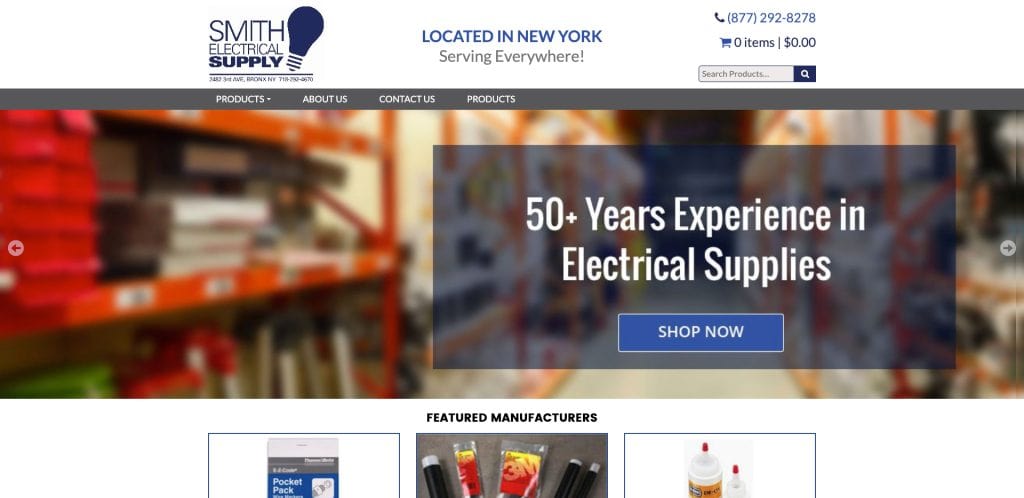
1. Smith Electric
Location: New York City, NY
Key Takeaways:
- Clear, concise service descriptions that make it easy for visitors to understand the offerings.
- Easy-to-find contact information and CTA buttons are prominently displayed.
- Professional design with a focus on brand consistency and trust-building.
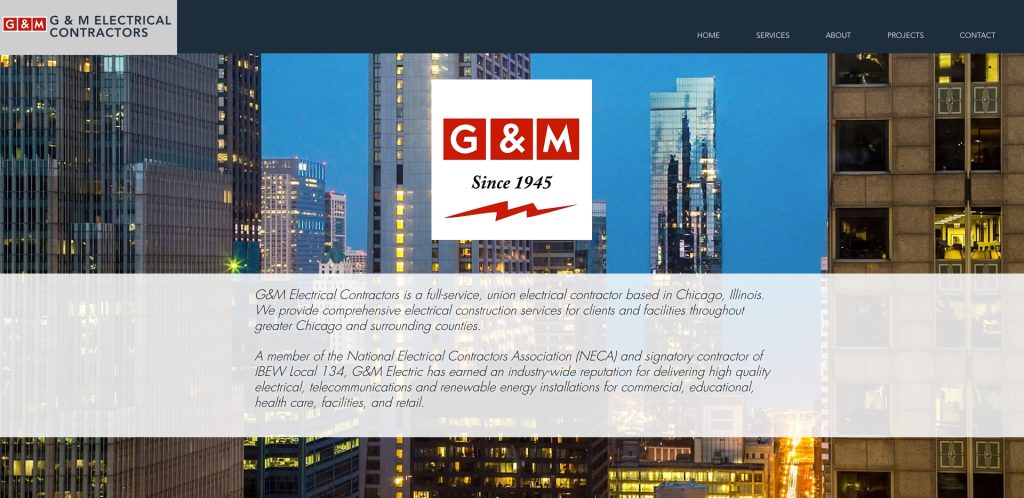
2. G&M Electric
Location: Chicago, IL
Key Takeaways:
- Engaging homepage with high-quality visuals showcasing completed projects.
- User-friendly navigation with separate service categories for residential, commercial, and industrial.
- Simple and intuitive request a quote form directly on the homepage.
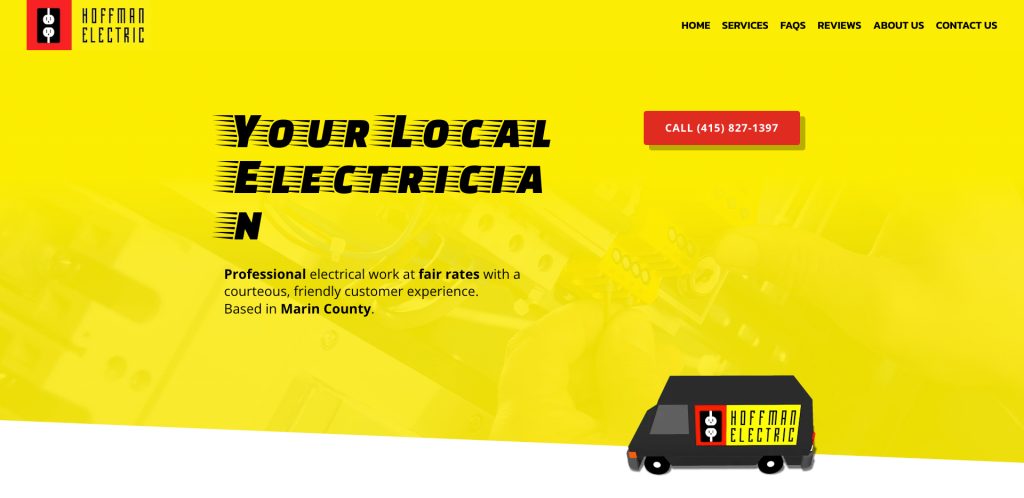
3. Hoffman Electric
Location: Los Angeles, CA
Key Takeaways:
- Prominent CTAs that encourage immediate action from website visitors.
- Aesthetically appealing project gallery showcasing detailed images of electrical work.
- Clear and accessible customer testimonials that build credibility.
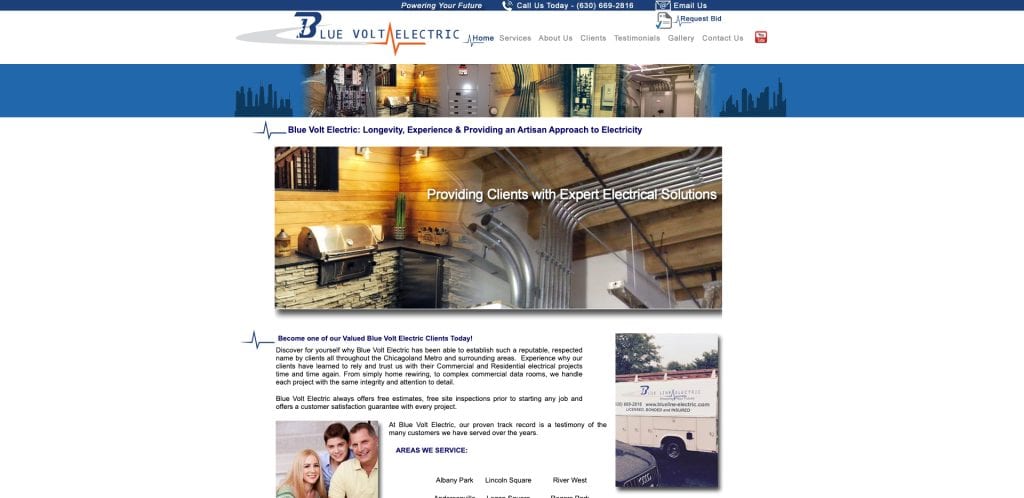
4. BlueVolt Electric
Location: Naperville, IL
Key Takeaways:
- Interactive service estimator tool that lets users calculate project costs.
- User-friendly mobile layout to ensure accessibility on all devices.
- In-depth FAQs section addressing common electrical issues and services.
5. Max Electric
Location: San Francisco, CA
Key Takeaways:
- Comprehensive list of services with detailed explanations for each.
- Social proof is integrated via Google reviews on the homepage.
- High-speed page load times optimized for user experience.
Website URL: www.maxelectric.us
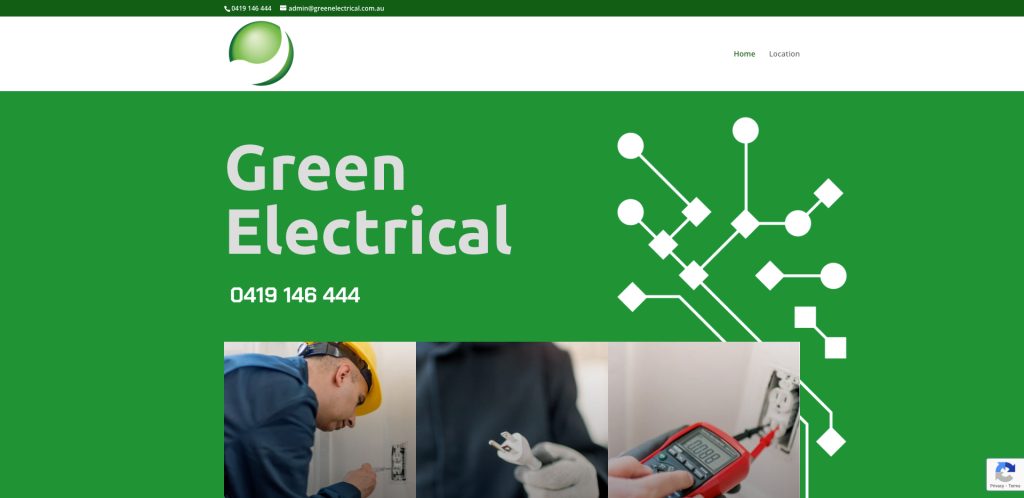
6. Green Electrical
Location: Australia
Key Takeaways:
- Clean, modern design with a focus on user experience.
- Clear service offerings and easy navigation.
- Responsive layout ensuring accessibility across devices.
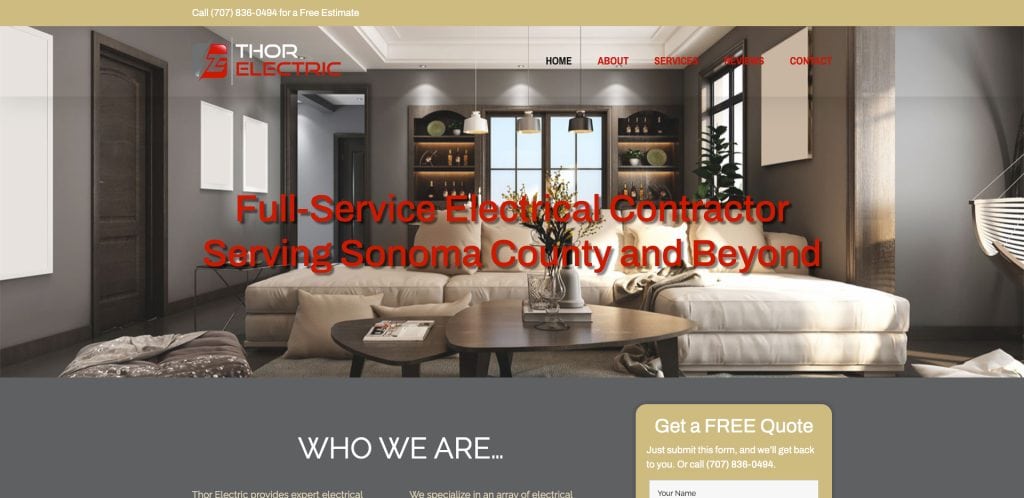
7. Thor Electric
Location: United States
Key Takeaways:
- Professional design aligns with industry standards.
- Intuitive navigation for seamless user experience.
- Comprehensive service information is readily available.
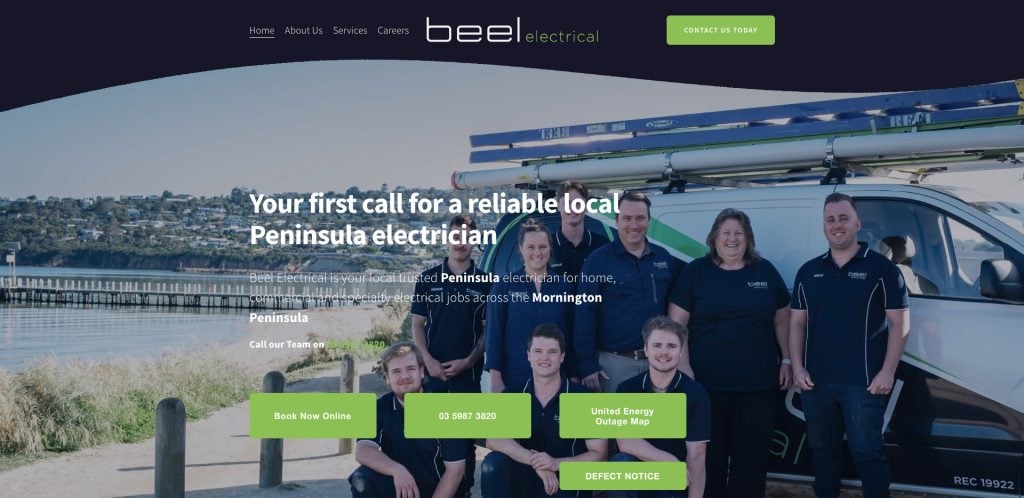
8. Beel Electrical
Location: Australia
Key Takeaways:
- Engaging homepage with a clear value proposition.
- Logical service segmentation for easy access.
- Consistent visual hierarchy enhances readability.
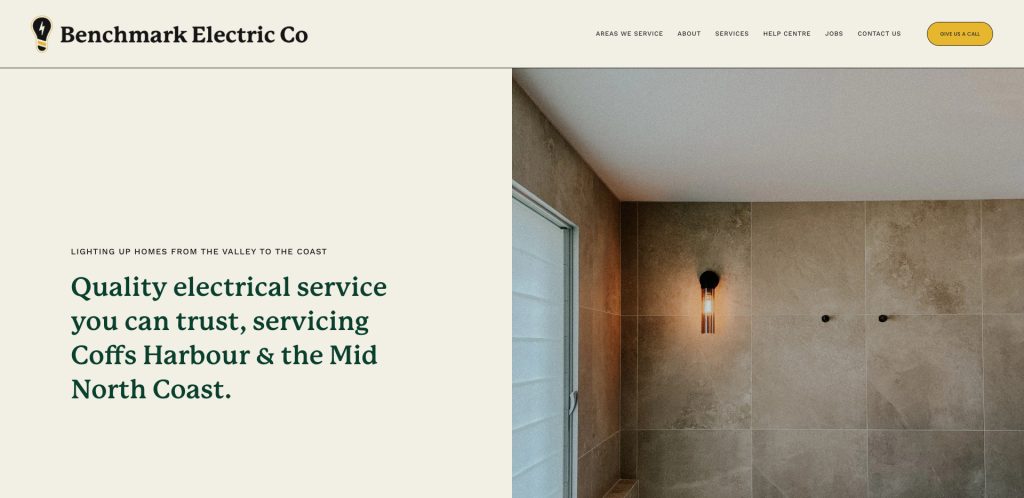
9. Benchmark Electric Co
Location: Australia
Key Takeaways:
- Minimalist design focusing on essential information.
- Strategic use of CTAs for lead generation.
- Effective use of whitespace for a clean layout.
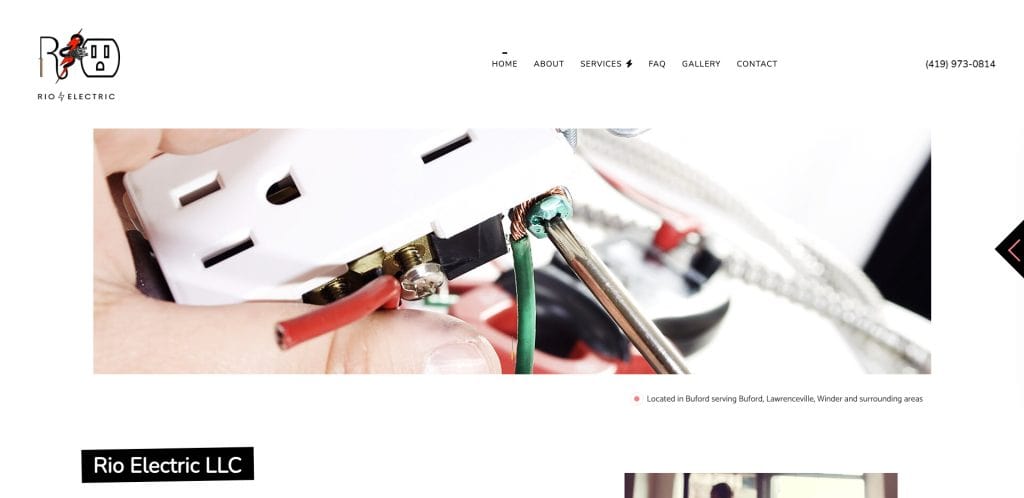
10. Rio Electric
Location: United States
Key Takeaways:
- Hero-centric design showcasing services prominently.
- Consistent branding with strong contrasts and typography.
- Emphasis on quality and affordability through design elements.
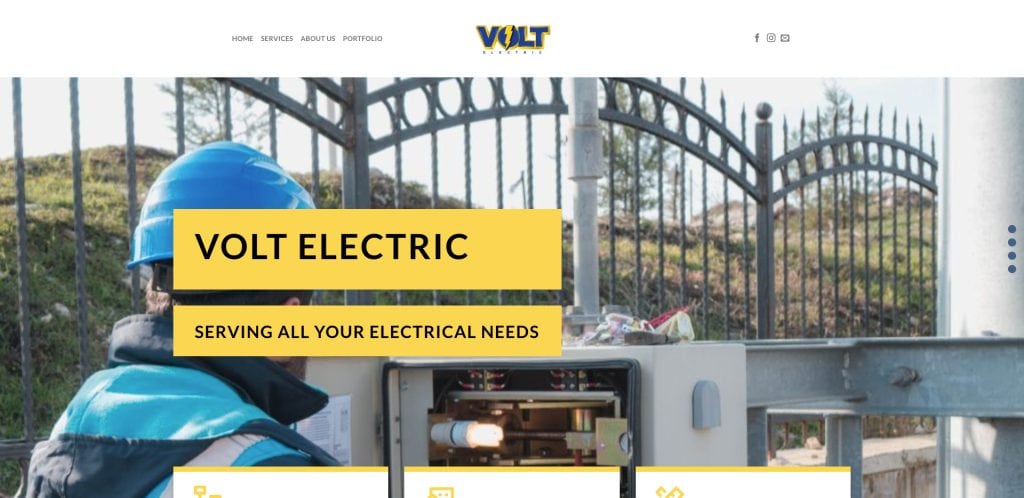
11. Volt Electric
Location: Denver, CO
Key Takeaways:
- Clean, modern aesthetic with easy navigation for both commercial and residential services.
- Service pages feature detailed service breakdowns, pricing, and clear CTAs.
- Local SEO practices are embedded throughout the site to attract customers in the Denver area.
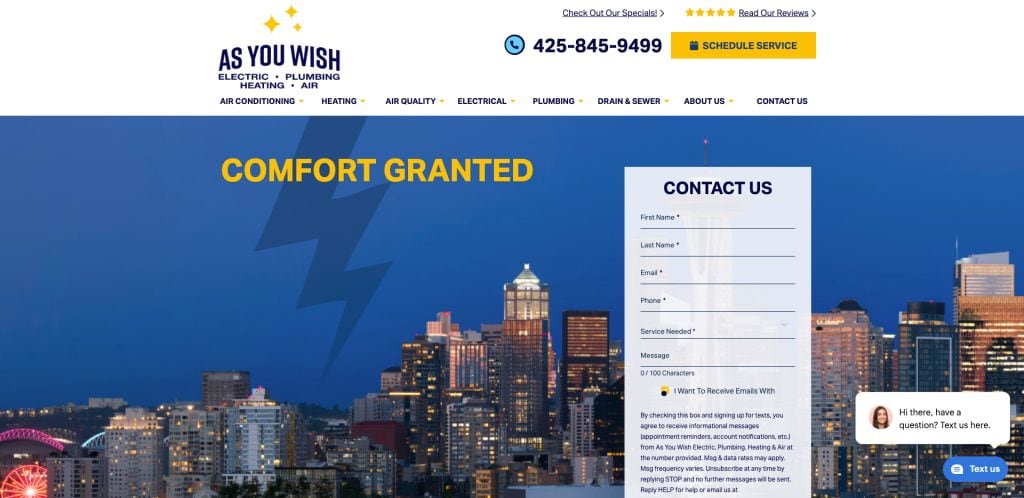
12. As You Wish Electric
Location: Seattle, WA
Key Takeaways:
- Comprehensive “About Us” section with a focus on company values and mission.
- Extensive FAQ section to help customers understand the range of services.
- High-quality visual design elements with an easy-to-follow layout.
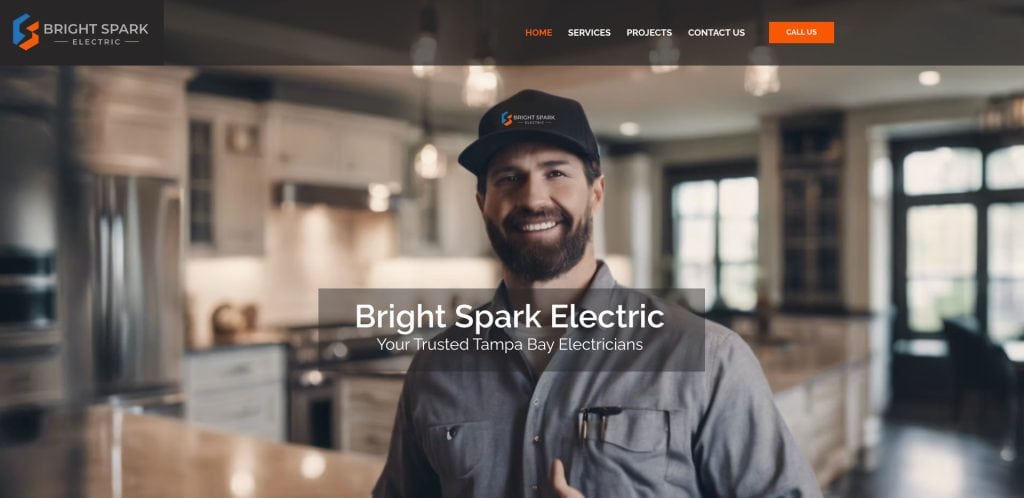
13. BrightSpark Electric
Location: Houston, TX
Key Takeaways:
- Streamlined user experience with fast-loading pages and responsive design.
- Integration of a customer portal for existing clients to track services and invoices.
- Bold CTAs and special offers are prominently featured throughout the site.
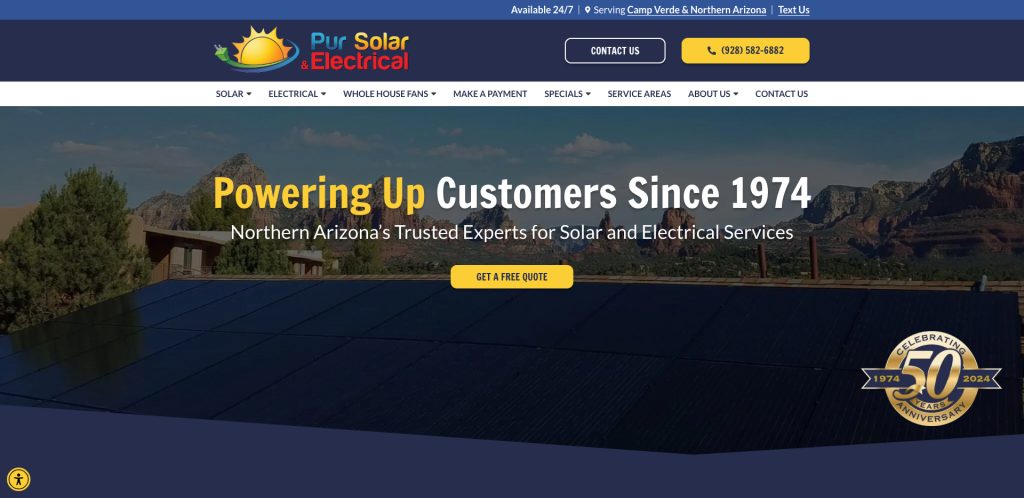
14. Pur Solar & Electrical
Location: Phoenix, AZ
Key Takeaways:
- High-impact visuals of work completed for both residential and commercial sectors.
- Clean design with a focus on easy contact through multiple forms of communication.
- Highlighting local projects to build trust in the Phoenix community.
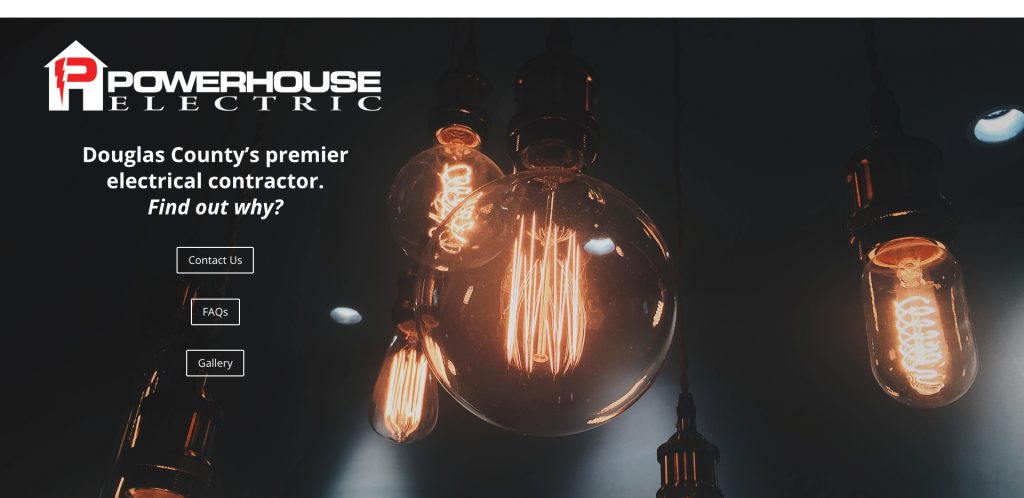
15. Powerhouse Electricians
Location: Portland, OR
Key Takeaways:
- An easy-to-navigate design with clearly segmented services for residential and commercial clients.
- A dedicated page showcasing services and related specialties.
- Effective use of social proof with client testimonials and five-star reviews.
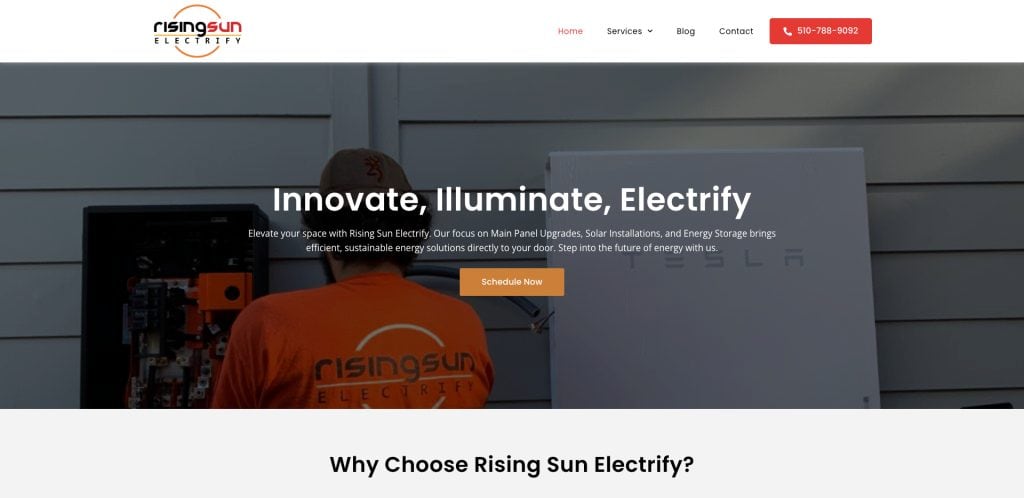
16. Rising Sun Electric
Location: San Diego, CA
Key Takeaways:
- Detailed “Request a Quote” section with form fields and service area options.
- High-end images of completed electrical work to engage visitors.
- Prominent contact details and CTAs to make inquiries and bookings simple.
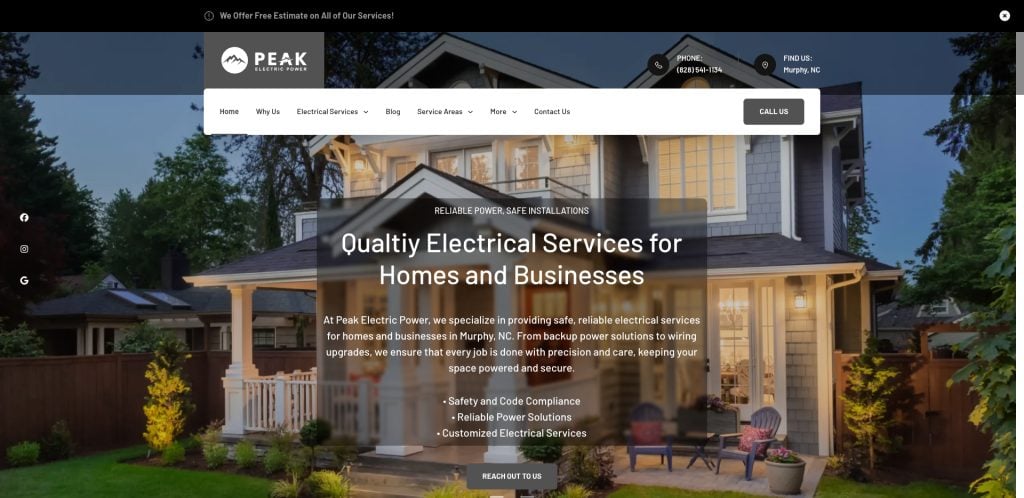
17. Peak Electric
Location: Murphy, NC
Key Takeaways:
- Visually striking homepage with a strong focus on service areas and availability.
- A well-organized website with accessible service descriptions.
- Smooth user experience with fast load times and minimal friction in navigation.
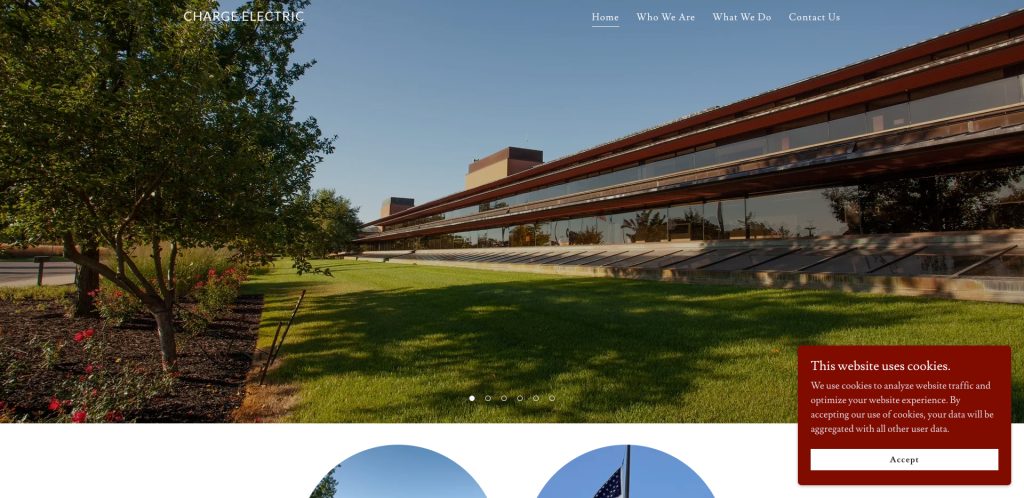
18. Charge Electric
Location: Orlando, FL
Key Takeaways:
- Simple and clean design that makes it easy to book electrical services.
- Prominent placement of CTAs to encourage quick conversions from visitors.
- Quick access to testimonials that speak to the company’s reliability and expertise.
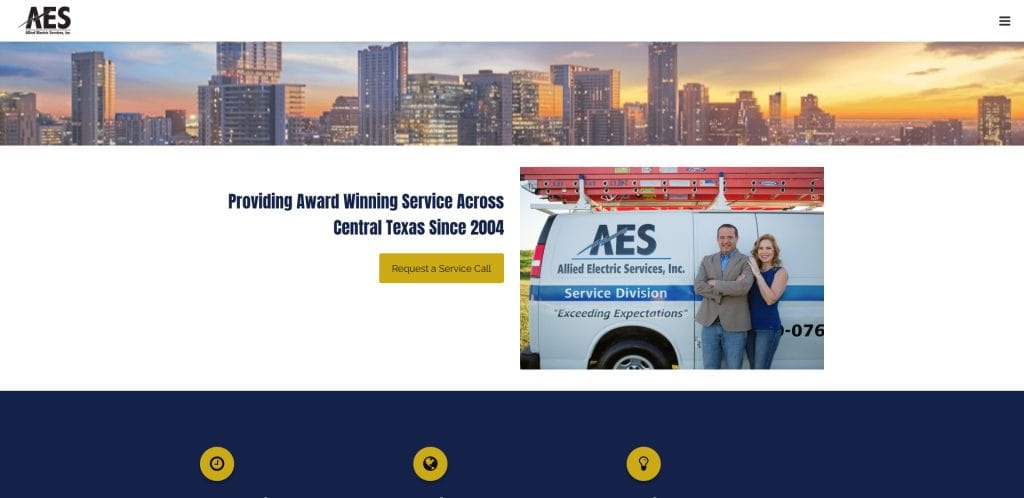
20. Allied Electricians
Location: Dallas, TX
Key Takeaways:
- A minimalistic design with a modern touch, emphasizing simplicity and usability.
- Showcasing diverse services with emphasis on industry marketing and lead generation.
- Consistent branding that reflects professionalism and trustworthiness.
Take Action: Build the Best Electrician Website for Your Business
Your website is the digital face of your business, and it’s the first place people will turn to when they are searching for electrical services. A well-designed website can be a game-changer for attracting new customers, enhancing your digital presence, and driving business growth. Whether you’re starting from scratch with a custom website or you’re looking for a website redesign to boost your website traffic, the steps outlined in this guide are designed to help you create a professional-looking, mobile-friendly website that meets the specific needs of your electrical business.
If you’re ready to take your business to the next level and build a well-organized website that showcases your services, including online booking and efficient electrical repairs, now is the time to act. Whether you’re exploring design ideas, web builders, or templates, remember that investing in a high-quality electrical website design is one of the best ways to stand out from the competition and connect with prospective clients who are searching for electrical services.
Start your journey to a better digital presence today. Design your website with the help of our professional website design and design services. Let’s create an effective, conversion-focused electrician website that drives results and supports your business goals.
Electrician Website Design Common Questions, Answered
What makes a professionally designed website stand out?
It stands out through a combination of sleek design, user-friendly navigation, and strategic content placement. Key features include clear calls to action, easy-to-find contact information, and a responsive design that adapts seamlessly across devices. A well-structured website layout allows visitors to quickly find the electrical services they need. Highlighting your expertise, client testimonials, and previous projects also adds credibility. Ensure your website reflects your business values, with website content that speaks to both your electrical needs and the solutions you offer.
How do I design a mobile-friendly website for my contractor’s business?
To design a mobile-friendly website for your business, you need to ensure that your design is responsive. This means the site should adjust its layout and content depending on the device being used, whether it’s a mobile phone, tablet, or desktop. Use design templates that are optimized for all screen sizes. Prioritize fast load times, intuitive navigation, and easy access to essential information like contact forms and service details. A professional-looking website will increase engagement, especially with website visitors browsing on mobile devices. For more tips on mobile optimization, check out our guide to website design.
What are some examples of the best site designs in this industry?
The best design examples share a few common traits: they are aesthetically appealing, easy to navigate, and optimized for conversion. These websites often feature service pages with clear information about the services offered, along with easy access to online booking or contact forms. Some examples also include portfolios or case studies to showcase completed projects. For inspiration, explore our electrician website examples and learn how you can apply these designs to your own service business.
How can I use marketing to grow my business?
It’s essential for attracting new clients and growing your business. Focus on local SEO to ensure your website ranks high when potential customers search for contractors in your area. Creating valuable content, such as blog posts or case studies, will improve search engine optimization and demonstrate your expertise. Leveraging social media and email marketing can keep your business top of mind with clients and encourage repeat business.
Should I use design templates or custom design for my website?
Whether to use them or to invest in a custom design depends on your budget, timeline, and specific business needs. Site design templates are a great starting point for businesses looking for a quick and cost-effective solution. They offer pre-built layouts that you can customize with your brand colors, logo, and content. However, a custom electrician website allows for a tailored design that aligns closely with your brand and the unique needs of your business. It also provides flexibility in terms of functionality and scalability. If you’re ready for a more personalized approach, consider our custom electrician web design services.
What are the benefits of having a one-page website for my electrician business?
A one-page website is an excellent choice for businesses that want to showcase their services in a concise, easy-to-navigate format. This design is particularly effective for service-based businesses, as it can present all key information—such as services, pricing, testimonials, and contact details—on a single page. One-page websites also load faster and are easier for users to digest, leading to better engagement and a higher chance of converting visitors into customers. If you’re considering a simple layout, a one-page website could be the perfect solution.
How does website layout impact user experience on an electrician’s website?
The website layout plays a significant role in how users interact with your site. A well-organized layout ensures that visitors can quickly find the information they’re looking for, from service offerings to contact details. For an effective website, prioritize clear headers, easy-to-use navigation, and a logical flow of information. Ensure that the most important sections, like electrician services, testimonials, and calls to action, are prominently displayed. A clean and simple website layout reduces clutter, helping users focus on the key details, which ultimately improves their experience and the likelihood of converting into leads.
What should be included in the website content for an electrician contractor website?
Website content for an electrician contractor website should provide clear, concise, and engaging information about the services you offer, the areas you serve, and your experience in the industry. Include detailed descriptions of your services, customer testimonials to cement trust, and easy access to booking or contact forms. Also, consider adding a blog to address common electrical issues or share maintenance tips. This type of content provides value to visitors and improves your SERPs. Keep the language simple and avoid jargon to make it accessible to a wider audience.
How can I ensure my site design meets my business goals?
Make sure it aligns with your business goals. Start by defining the key objectives of your website. Are you aiming to generate leads, increase brand awareness, or provide information about your services? Once you’ve outlined your goals, choose a professional design that reflects those priorities. Whether it’s showcasing your expertise with service examples or simplifying the booking process through online booking, your website should be optimized to drive the actions that matter most to your business. Keep tracking performance through tools like Google Analytics to see if your design is helping you meet those goals and adjust as necessary.
What should I consider when choosing website templates for my electrician web design?
When choosing website templates, ensure that they align with your brand and business needs. Look for some that offer customizable layouts, easy navigation, and responsive designs. It should be flexible enough to incorporate your services, website content, and unique business features like online booking. Consider your long-term business goals—if you plan to expand, ensure the one you choose can grow with your business. For further guidance on these, check out our guide to designing your electrician website.



